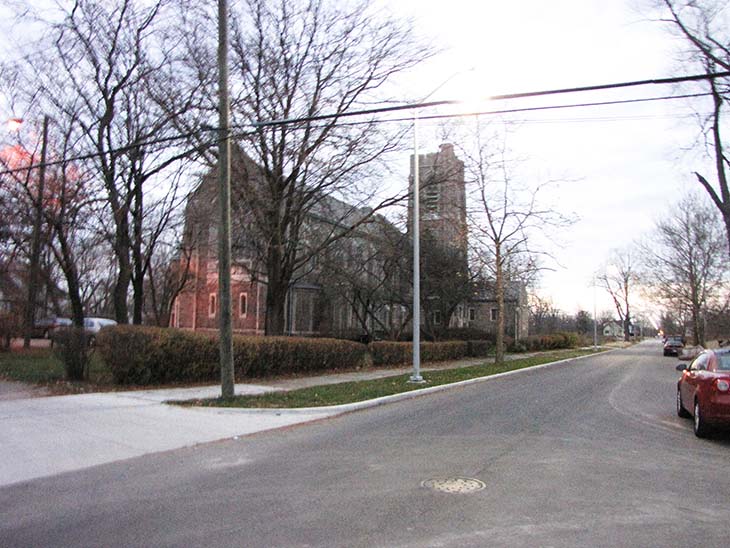

This is a very attractive, if typical, Gothic structure reminding us of the architectural skills that craftsmen in northern Europe perfected by the 14th century. St Columba parish was founded in 1913 as a missionary church by Christ Church located near downtown on East Jefferson. St. Columba’s parish remained in operation until 2003. The architect for this church, Lancelot Sukert, also designed the impressive parish house on the west side of Jefferson that stands nearby, also abandoned. Sukert also designed St. Paul’s Episcopal located near the intersection of Grand River and Hubbell on the west side. He built a parish house for that church along Grand River that looked almost exactly like what you see here at East Jefferson and Manistique. Sukert’s best known work in Detroit is the Scarab Club located on John R in the Cultural Center. He also designed, in the 1930s, the St. Lazarus Serbian Orthodox Cathedral located at 4575 Outer Drive East. That Orthodox Church has been replaced with a new cathedral at approximately the same location.
The pope began sending missionaries to convert the Gaelic population of Ireland as early as the 430s. St. Patrick was, I believe, the most acclaimed of these missionaries but not the first. Apparently the rulers of Ireland and the Irish population quite quickly gave up their Druid beliefs and adopted Roman Catholicism, although the missionaries incorporated many elements of the Druid faith in the religion they successfully preached. A substantial religious shift in Ireland occurred quite thoroughly within three or four generations.
St. Columba, whose Gaelic name was Colum Cille, meaning “dove of the Church”, was born in Donegal on December 7, 521. His Norse name was Kolbjøm, meaning “black bear.” Columba was a member of a royal family; the descendent of a fifth century Irish king. He studied at the Clonard Abbey which was then a center for Catholic thought and scholarship in Ireland. He developed a facility for copying and writing manuscripts. He may have written 30 books during this life time but only two survive to this day.
In 563, Columba and twelve of his companions sailed to the Kintyre peninsula in Scotland to begin evangelizing the native people there, then known as Picts, who spoke a Gaelic language similar to that spoken in Ireland. Columba and his colleagues founded numerous churches and monasteries in mainland Scotland and on the Herbrides Islands, thus making Columba a key figure in the Christianization of Scotland. Coloumba died on June 9. 597 on the island of Iona and was buried at a monastery that he founded there. I am not sure why the Episcopalian leaders in Detroit early in the last century selected the name of the saint who help to convert the Scots to Christianity. So far as I know, there were no large settlements of Scottish immigrants on the east side of Detroit at this time.
The church was vacant for several years but more recently has been home to the Detroit Faith Center congregation.
Architect: Lancelot Sukert
Architectural Style: Gothic
Date of Construction: Mid-1920s, I presume
Use in 2010: Detroit Faith Center
Facebook page for Detroit Faith Center: http://www.facebook.com/pages/Detroit-Faith-Center/382634064492
City of Detroit Designated Historic Districts: Not listed
State of Michigan Registry of Historic Sites: Not listed
National Register of Historic Places: Not listed
Photograph: Ren Farley; November, 2009
Description updated: September 2011